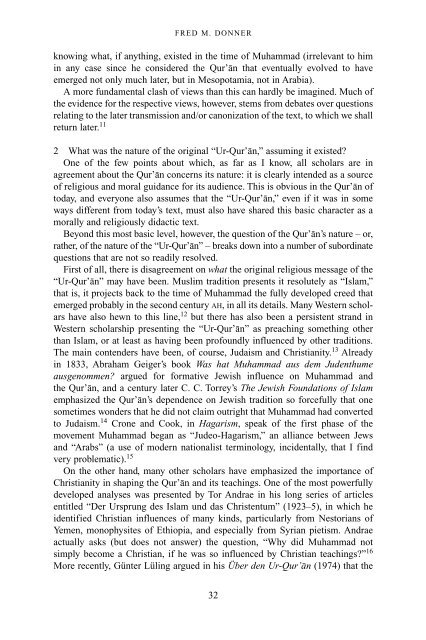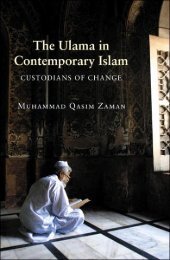The Qur'an in its historical context (pdf - Islam and Christian-Muslim ...
The Qur'an in its historical context (pdf - Islam and Christian-Muslim ...
The Qur'an in its historical context (pdf - Islam and Christian-Muslim ...
You also want an ePaper? Increase the reach of your titles
YUMPU automatically turns print PDFs into web optimized ePapers that Google loves.
FRED M. DONNER<br />
know<strong>in</strong>g what, if anyth<strong>in</strong>g, existed <strong>in</strong> the time of Muhammad (irrelevant to him<br />
<strong>in</strong> any case s<strong>in</strong>ce he considered the Qur’an that eventually evolved to have<br />
emerged not only much later, but <strong>in</strong> Mesopotamia, not <strong>in</strong> Arabia).<br />
A more fundamental clash of views than this can hardly be imag<strong>in</strong>ed. Much of<br />
the evidence for the respective views, however, stems from debates over questions<br />
relat<strong>in</strong>g to the later transmission <strong>and</strong>/or canonization of the text, to which we shall<br />
return later. 11<br />
2 What was the nature of the orig<strong>in</strong>al “Ur-Qur’an,” assum<strong>in</strong>g it existed?<br />
One of the few po<strong>in</strong>ts about which, as far as I know, all scholars are <strong>in</strong><br />
agreement about the Qur’an concerns <strong>its</strong> nature: it is clearly <strong>in</strong>tended as a source<br />
of religious <strong>and</strong> moral guidance for <strong>its</strong> audience. This is obvious <strong>in</strong> the Qur’an of<br />
today, <strong>and</strong> everyone also assumes that the “Ur-Qur’an,” even if it was <strong>in</strong> some<br />
ways different from today’s text, must also have shared this basic character as a<br />
morally <strong>and</strong> religiously didactic text.<br />
Beyond this most basic level, however, the question of the Qur’an’s nature – or,<br />
rather, of the nature of the “Ur-Qur’an” – breaks down <strong>in</strong>to a number of subord<strong>in</strong>ate<br />
questions that are not so readily resolved.<br />
First of all, there is disagreement on what the orig<strong>in</strong>al religious message of the<br />
“Ur-Qur’an” may have been. <strong>Muslim</strong> tradition presents it resolutely as “<strong>Islam</strong>,”<br />
that is, it projects back to the time of Muhammad the fully developed creed that<br />
emerged probably <strong>in</strong> the second century AH, <strong>in</strong> all <strong>its</strong> details. Many Western scholars<br />
have also hewn to this l<strong>in</strong>e, 12 but there has also been a persistent str<strong>and</strong> <strong>in</strong><br />
Western scholarship present<strong>in</strong>g the “Ur-Qur’an” as preach<strong>in</strong>g someth<strong>in</strong>g other<br />
than <strong>Islam</strong>, or at least as hav<strong>in</strong>g been profoundly <strong>in</strong>fluenced by other traditions.<br />
<strong>The</strong> ma<strong>in</strong> contenders have been, of course, Judaism <strong>and</strong> <strong>Christian</strong>ity. 13 Already<br />
<strong>in</strong> 1833, Abraham Geiger’s book Was hat Muhammad aus dem Judenthume<br />
ausgenommen? argued for formative Jewish <strong>in</strong>fluence on Muhammad <strong>and</strong><br />
the Qur’an, <strong>and</strong> a century later C. C. Torrey’s <strong>The</strong> Jewish Foundations of <strong>Islam</strong><br />
emphasized the Qur’an’s dependence on Jewish tradition so forcefully that one<br />
sometimes wonders that he did not claim outright that Muhammad had converted<br />
to Judaism. 14 Crone <strong>and</strong> Cook, <strong>in</strong> Hagarism, speak of the first phase of the<br />
movement Muhammad began as “Judeo-Hagarism,” an alliance between Jews<br />
<strong>and</strong> “Arabs” (a use of modern nationalist term<strong>in</strong>ology, <strong>in</strong>cidentally, that I f<strong>in</strong>d<br />
very problematic). 15<br />
On the other h<strong>and</strong>, many other scholars have emphasized the importance of<br />
<strong>Christian</strong>ity <strong>in</strong> shap<strong>in</strong>g the Qur’an <strong>and</strong> <strong>its</strong> teach<strong>in</strong>gs. One of the most powerfully<br />
developed analyses was presented by Tor Andrae <strong>in</strong> his long series of articles<br />
entitled “Der Ursprung des <strong>Islam</strong> und das Christentum” (1923–5), <strong>in</strong> which he<br />
identified <strong>Christian</strong> <strong>in</strong>fluences of many k<strong>in</strong>ds, particularly from Nestorians of<br />
Yemen, monophysites of Ethiopia, <strong>and</strong> especially from Syrian pietism. Andrae<br />
actually asks (but does not answer) the question, “Why did Muhammad not<br />
simply become a <strong>Christian</strong>, if he was so <strong>in</strong>fluenced by <strong>Christian</strong> teach<strong>in</strong>gs?” 16<br />
More recently, Günter Lül<strong>in</strong>g argued <strong>in</strong> his Über den Ur-Qur’an (1974) that the<br />
32



